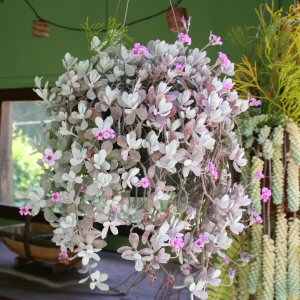The “Flower Dust Plant” is a silvery succulent that grows in a low, clump-like shape. Its leaves are long and coated in white, powdery-looking hairs, giving it a “dusty” appearance. It occasionally produces small pink flowers.
Table of Contents
Care and Propagation Information
The Kalanchoe pumila, or “Flower Dust Plant,” is a fantastic choice for rock gardens or hanging baskets. It has a low-growing, shrub-like structure that is native to Madagascar and spreads out as it matures.
Watering
For optimal care of Kalanchoe pumila “Flower Dust Plant”, it is recommended to use the “soak and dry” method of watering, allowing the soil to become completely dry between each watering.
Where to Plant
If you live in an area where temperatures drop below 20° F (-6.7° C), it’s best to keep the Flower Dust Plant in a pot that can be brought indoors. It does best when exposed to full or partial sunlight.
How to Propagate Kalanchoe pumila “Flower Dust Plant”
Kalanchoe pumila “Flower Dust Plant” can be propagated through taking stem cuttings or leaves, but stem cuttings will likely yield more successful results.
Cuttings
To propagate the “Flower Dust Plant” by cuttings, use a sharp, clean knife or scissors and take a cutting from the main plant. Allow the cutting to dry and develop a callous over a few days before potting it in a fast-draining soil. Make sure to keep the soil moistened at all times by watering it when it has become completely dry.
Leaves
To increase the chances of “Flower Dust Plant” propagation, carefully remove a leaf from the parent plant, making sure that none of the leaf remains attached to the stem.
Let the leaf sit for a few days until the end is hardened, then put it in soil that drains well. Water the soil only when it is totally dry.
Care and Propagation Information
General Care for Kalanchoe pumila “Flower Dust Plant”
Watering
For optimal care of Kalanchoe pumila “Flower Dust Plant”, it is recommended to use the “soak and dry” method of watering, allowing the soil to become completely dry between each watering.
Where to Plant
If you live in an area where temperatures drop below 20° F (-6.7° C), it’s best to keep the Flower Dust Plant in a pot that can be brought indoors. It does best when exposed to full or partial sunlight.
How to Propagate Kalanchoe pumila “Flower Dust Plant”
Kalanchoe pumila “Flower Dust Plant” can be propagated through taking stem cuttings or leaves, but stem cuttings will likely yield more successful results.
Cuttings
To propagate the “Flower Dust Plant” by cuttings, use a sharp, clean knife or scissors and take a cutting from the main plant. Allow the cutting to dry and develop a callous over a few days before potting it in a fast-draining soil. Make sure to keep the soil moistened at all times by watering it when it has become completely dry.
Leaves
To increase the chances of “Flower Dust Plant” propagation, carefully remove a leaf from the parent plant, making sure that none of the leaf remains attached to the stem.
Let the leaf sit for a few days until the end is hardened, then put it in soil that drains well. Water the soil only when it is totally dry.
FAQ
Is a kalanchoe a perennial or annual?
Kalanchoe is a dark green, evergreen succulent with scalloped leaves and tall, showy umbels of flowers perched atop the foliage (Figure 1).
How do you care for a kalanchoe Pumila plant?
You must ensure your Kalanchoe Pumila stays healthy by providing it with ample amounts of indirect, bright sunlight, a well-draining soil mixture, occasional feeding during its growing season, and minimal watering. This particular succulent is known for its beauty and ease of care.
Is kalanchoe pumila a succulent?
Kalanchoe pumila, commonly known as the Flower Dust Plant, is a succulent shrub native to the mountainous regions of Madagascar. This plant reaches a height of 8 to 12 inches. It is adapted to the rocky soils in its native habitat.
How do you care for a pumila succulent?
Do kalanchoe flowers come back every year?
Kalanchoes are perennials in climates between zones 8-10, meaning that with the proper conditions, they will come back every year. However, if temperatures dip below 40°F for extended periods, the flowers will not return. Despite this, houseplants can be used to ensure the blooms come back annually.



